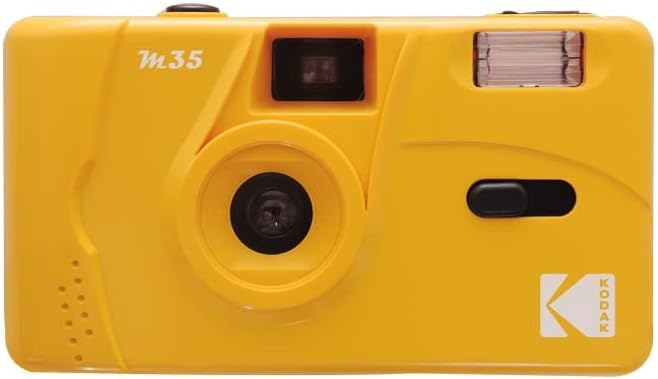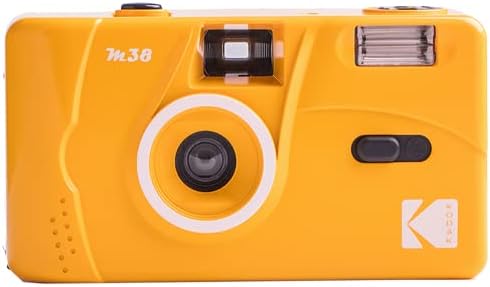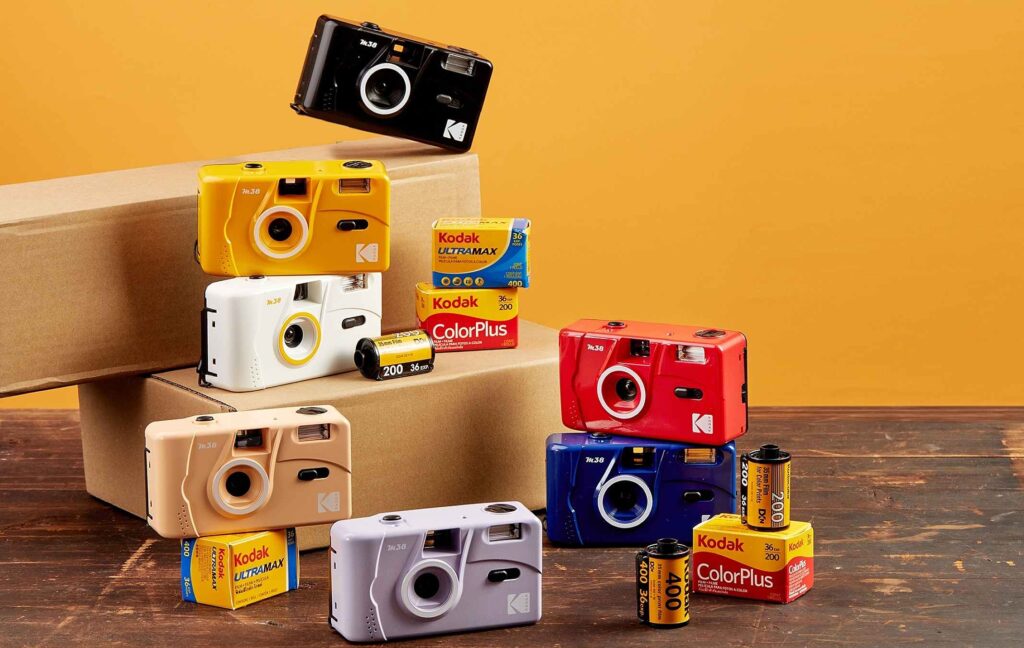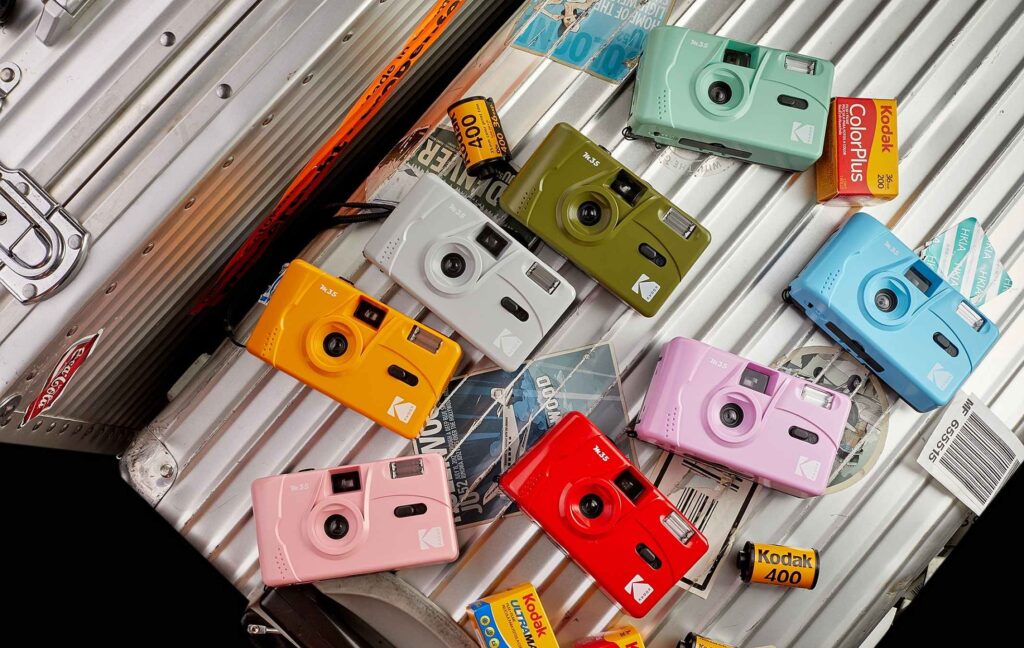In the world of photography, the rise of lo-fi plastic cameras has been a noteworthy trend, emphasizing simplicity and a return to the roots of analog. Within this trend, the Kodak M35 and M38 film cameras have emerged as popular choices for photographers.
The Kodak M35 is a reusable 35mm film camera introduced in 2019. It is a reliable, user-friendly camera designed to deliver the unique aesthetic of film photography. The Kodak M38, a successor to the M35, maintains the simplicity of the earlier model while introducing several improvements, offering more features to users.
This article will explore the key characteristics of both cameras, provide a comparison between them, and delve into the broader context of their role in the resurgence of film photography. If you’re considering stepping into the world of analog photography or adding a new camera to your collection, the Kodak M35 and M38 merit your attention.
The Kodak M35: A Detailed Overview
I’ve found the Kodak M35 to be a simple, functional 35mm film camera that harkens back to the basics of photography. It has a 31mm fixed focus lens, an aperture of f/10, and a shutter speed of 1/120s. These specifications make it a solid choice for shooting in daylight, particularly with ISO 200 or 400 film.
The M35 incorporates a manual wind and rewind mechanism for the film, a feature that nostalgically echoes traditional analog photography practices. To power its built-in flash, the M35 utilizes a single AAA alkaline battery. However, I’ve noticed the flash isn’t particularly strong, with an effective range of 1-4 meters for ISO 200 film and 1-5 meters for ISO 400 film. It’s sufficient for low-light conditions but can affect image sharpness.
The design of the M35 is quite appealing, with its nostalgic aesthetic and ABS plastic body available in an array of vibrant colors including red, yellow, green, purple, sky blue, and candy pink. Despite its plastic construction, the M35 provides a reasonably focused image, courtesy of its curved film plane. In bright conditions, the image quality is generally good, but some softening at the edges and in low-light situations can be expected. The camera also shows some chromatic aberrations and pincushion distortion, but these are not atypical for cameras in its class.
Related articles that might be interesting for you:
- Best Film Choices for Kodak M35 and M38
- Are Disposable Cameras Bad for the Environment?
- What kind of film should a beginner use?
The Kodak M38: Advancements and Improvements
The Kodak M38, as a successor to the M35, retains the ease of use and charm of the M35 but introduces key improvements that enhance the overall experience with the camera. One significant enhancement is the camera’s flash, which is 30% stronger than the M35’s. This upgraded flash allows for improved performance in low-light conditions and contributes to the overall image quality. The M38 is slightly heavier than the M35, providing a better hold and control.
Another improvement in the M38 that I appreciate is the design of the film chamber. Equipped with eight sprockets, the film is held more securely, ensuring a reliable performance from the first to the last frame. This improved film hold feature increases the camera’s durability, making it resistant to common film issues such as tears or misfeeds. The M38 maintains the colorful appeal of the M35, offering the camera in six high-contrast colorways. Despite these enhancements, the M38 preserves the lens specifications of the M35 – a 31mm, F=10, single-element lens, and a fixed shutter speed of 1/120s – maintaining the characteristic image quality of this camera line.
Direct Comparison Between the M35 and M38, which one is better?


When you put the M35 and M38 side by side, it’s clear that the differences between the two are minimal. They both sport a 31mm fixed focus lens with an f/10 aperture and operate at a fixed shutter speed of 1/120s, making for near-identical lens quality and shooting modes. The M38 does have a 30% stronger flash, but the real-world impact of this improvement might only be noticeable in low-light conditions.
The M38 is a bit weightier than its predecessor, but I find that this additional heft actually improves stability while shooting, rather than hindering it. One of the standout improvements of the M38, in my opinion, is its enhanced film loading process. Its eight-sprocket design in the film chamber offers a more secure film hold, increasing resilience against common film issues like tears or misfeeds. I’ve heard fellow enthusiasts share stories of spoiled films due to such problems, so this improvement shouldn’t be underestimated.
Aesthetically, the M35 and M38 both hit the mark with their vibrant color options. Both models come in six shades, although the M38 offers higher-contrast variants.
All in all, if you’re considering an upgrade from the M35 to the M38, it may not be worth it unless the price points are similar and you value the few additional features. You can check their latest prices for the M35 and also the M38 on Amazon. However, if the improved sprockets and the stronger flash appeal to you, the M38 may just be a worthwhile investment.
What film is recommended for the M35 and M38?
Given the fixed settings of the M35 and M38 – an aperture of f/10 and a shutter speed of 1/120s – the optimal performance is typically achieved with ISO 200 or 400 film. These films strike a nice balance between light sensitivity and graininess, making them well-suited for these cameras. That being said, if you’re well-versed in film exposure and are comfortable pushing boundaries, you could experiment with different ISOs. Just bear in mind that deviations from the recommended ISOs might lead to underexposed or overexposed results, depending on lighting conditions.
As these cameras are geared more towards casual, snapshot photography, I’d advise against investing in expensive film stocks. Instead, consider more cost-effective options like Kodak ColorPlus 200 and Fujifilm 200 for color, and Ilford HP5 Plus or Kentmere 400 for black and white. They provide reasonable image quality at a fraction of the price, making them ideal for this kind of photography. I’d recommend steering clear of slide film for these cameras, due to its limited exposure latitude. The fixed settings on the M35 and M38 might not lend themselves well to the precision required for slide film, potentially leading to disappointing results. Stick to cheaper, more forgiving film types and you’re sure to capture some great shots.
Cost and Value
Both the M35 and M38 are positioned as affordable entries in the world of analog photography. Despite the M38 offering several improvements over the M35, the price difference between the two models isn’t substantial. When considering value for money, the M38 seems to be a more compelling option due to its improved flash, weight, and film hold.
Usability and User Experience
Both the M35 and M38 are user-friendly, making them a good choice for beginners looking to delve into the world of film photography. The manual wind and rewind mechanism might be a new experience for those used to digital cameras, but it’s straightforward and adds to the analog photography charm.
In terms of reusability, both models excel. Unlike disposable cameras, the M35 and M38 can be used repeatedly, contributing to their value proposition. However, the M38’s superior film hold could potentially prolong its lifespan compared to the M35.
Conclusion

To summarize, both the Kodak M35 and M38 provide an appealing blend of simplicity and functionality, making them perfect for photographers seeking a lo-fi, analog experience. While they share similar design aesthetics and key specifications, the M38 does hold a slight edge with its stronger flash, improved film security, and increased weight for better stability.
It’s worth noting that the decision between these two models largely comes down to personal preferences and your specific photographic needs. If you value a better flash and film security, and can find the M38 at a similar price point to the M35, the M38 may be the better choice. However, if these improvements are of less importance to you, the M35 can still provide a satisfactory shooting experience.
FAQ
How to properly load film into the Kodak M35 and M38?
For both cameras, loading film involves opening the camera back, inserting the film cartridge in the left compartment, pulling the film tip across the camera to the take-up spool on the right, and then winding the film onto the spool. Remember to close the camera back before advancing the film to the first frame. You can check the video below for more info.
Can I use black and white film in the M35 and M38?
Absolutely. Both the M35 and M38 can be used with black and white film. Just be aware that, due to the cameras’ fixed settings, it’s important to choose a film with a suitable ISO – typically ISO 200 or 400.
What are some care and maintenance tips for the M35 and M38
For both models, avoid exposing the camera to extreme temperatures and keep it clean from dust and dirt. Always wind the film gently to avoid tearing or misfeeds. If the camera gets wet, dry it thoroughly as soon as possible.
What are some common troubleshooting tips?
If the camera isn’t functioning properly, check the film loading and battery first. Make sure the film is properly wound and that the battery has sufficient power. If you’re having issues with image quality, consider the lighting conditions and the type of film being used.
What photographic conditions are the M35 and M38 best suited for?
Given their specifications, both the M35 and M38 perform best in well-lit conditions, such as outdoor daylight photography. Their built-in flash also allows for indoor or low-light photography, though with some limitations in image sharpness and range.

